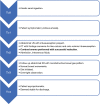Ingestion of kinetic sand leading to intussusception and bowel obstruction in a child: a case report
- PMID: 38234341
- PMCID: PMC10789891
- DOI: 10.21037/acr-23-37
Ingestion of kinetic sand leading to intussusception and bowel obstruction in a child: a case report
Abstract
Background: Kinetic sand is a type of play sand that is marketed to children above the age of three years old. It is comprised of sand coated with silicone oil, holding its shape when squeezed or pressed. It is described as a non-toxic, hypoallergenic, safe sand for arts and crafts, and is highly appealing due to its realistic appearance and odor. We present the first reported case of bowel obstruction due to small and large bowel intussusceptions caused by ingestion of kinetic sand leading to hospitalization for medical treatment in a young girl.
Case description: We present a two-year-old female patient with a past medical history of autism, trichotillomania, and pica who presented to our hospital as a transfer for two days of abdominal pain and non-bloody bilious emesis. Radiographic workup included abdominal ultrasound, abdominal X-ray, and computed tomography that revealed both small bowel intussusceptions and colo-colonic intussusception. Fluoroscopic gastrografin enema was performed and yielded free reflux of contrast into the distal ileum. The admitted patient continued to pass the sand with an eventual resolution of abdominal pain.
Conclusions: Intussusception is considered a medical emergency and should be treated as soon as possible before potentially fatal complications occur. This report serves to highlight the potential dangers of kinetic sand ingestion and provide guidance for the management of intussusception and bowel obstruction after kinetic sand ingestion in the pediatric population.
Keywords: Small bowel obstruction; case report; kinetic sand; pediatric emergency.
2024 AME Case Reports. All rights reserved.
Conflict of interest statement
Conflicts of Interest: All authors have completed the ICMJE uniform disclosure form (available at https://acr.amegroups.com/article/view/10.21037/acr-23-37/coif). The authors have no conflicts of interest to declare.
Figures






References
-
- Popular Mechanics. The Boy Mechanic: Volume II: 1000 Things for Boys to Do. Chicago: Popular Mechanics Press; 1915.
Publication types
LinkOut - more resources
Full Text Sources
Miscellaneous
